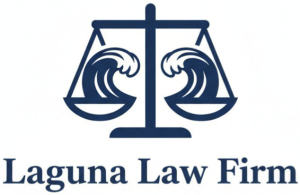Sustaining a work-related injury can turn your life upside down, leaving you with medical bills, lost wages, and uncertainty about your future. In California, securing workers’ compensation benefits hinges on proving that your injury is work-related—a process that can be complex and daunting without the right guidance. At Laguna Law Firm, our dedicated California workers’ compensation attorneys are here to help injured workers navigate this critical step and secure the benefits they deserve. Contact us at (949) 930-1386 or visit lagunalawfirm.com for a free consultation.
In this comprehensive guide, optimized for injured workers seeking legal help for workers’ comp claims in California, we’ll walk you through how to prove your injury is work-related, share expert tips to strengthen your case, and explain how Laguna Law Firm can support you. With the right approach, you can overcome insurance company challenges and get the compensation you’re entitled to. Let’s dive into the essentials of proving a work-related injury in California.
Why Proving a Work-Related Injury Matters
In California’s workers’ compensation system, benefits are available to employees who suffer injuries or illnesses arising out of and in the course of employment (AOE/COE). Proving that your injury is work-related is the cornerstone of a successful California workers’ comp claim. If you can’t establish this connection, insurance companies may deny your claim, leaving you without coverage for medical expenses, disability payments, or rehabilitation.
Common work-related injuries include:
- Acute Injuries: Slips, falls, or equipment accidents causing fractures, sprains, or cuts.
- Repetitive Strain Injuries: Conditions like carpal tunnel syndrome from repetitive tasks.
- Occupational Illnesses: Respiratory issues or skin conditions from exposure to workplace hazards.
- Psychological Injuries: Stress-related conditions caused by workplace trauma, if substantiated.
Insurance companies often scrutinize claims to avoid payouts, so building a strong case is critical. At Laguna Law Firm, we help injured workers in California gather the evidence needed to prove their injury is work-related and secure maximum benefits.
7 Key Steps to Prove Your Injury is Work-Related
Proving a work-related injury requires careful documentation and a strategic approach. Follow these steps to strengthen your California workers’ compensation claim:
1. Report the Injury Immediately
California law requires you to report your injury to your employer within 30 days of the incident or when you became aware of the injury (for cumulative injuries like repetitive strain). Prompt reporting establishes a clear timeline and demonstrates that your injury occurred at work. Failure to report on time can jeopardize your claim.
How to Report:
- Notify your supervisor or HR in writing (email or a formal incident report).
- Include details like the date, time, location, and how the injury occurred.
- Keep a copy of the report for your records.
Pro Tip: If your employer delays or refuses to provide a claim form (DWC-1), contact Laguna Law Firm at (949) 930-1386. We can ensure your rights are protected.
2. Seek Medical Attention Promptly
A doctor’s evaluation is critical to documenting your injury and linking it to your work. Visit a physician approved by your employer’s workers’ compensation insurance or, if allowed, your own doctor. Be specific about how the injury happened and its connection to your job duties.
What to Tell Your Doctor:
- Describe the work-related incident or repetitive tasks that caused the injury.
- Detail your symptoms and limitations (e.g., “I can’t lift more than 10 pounds due to back pain”).
- Avoid downplaying or exaggerating your condition—honesty is key.
Medical records serve as primary evidence in your claim, so ensure they clearly state the injury’s work-related nature. At Laguna Law Firm, we collaborate with your medical team to ensure your records support your case.
3. Gather Evidence of the Work-Related Incident
Strong evidence is essential to prove your injury occurred at work. Collect the following:
- Incident Reports: Obtain a copy of your employer’s accident report or file one if it doesn’t exist.
- Witness Statements: Ask coworkers who saw the incident or can confirm your work conditions to provide written statements.
- Photos or Videos: Document the accident scene, equipment involved, or hazardous conditions (e.g., a wet floor or faulty machinery).
- Work Records: Pay stubs, schedules, or job descriptions can show your duties and exposure to injury risks.
This evidence helps establish the AOE/COE requirement. Our attorneys at Laguna Law Firm can help you collect and organize these materials to build a compelling case.
4. Document Your Symptoms and Limitations
For injuries that develop over time, like repetitive strain or occupational illnesses, detailed documentation is crucial. Keep a daily journal noting:
- Specific symptoms (e.g., pain, swelling, or fatigue).
- How symptoms affect your ability to work or perform daily tasks.
- Any work activities that worsen your condition.
This record can demonstrate a pattern linking your injury to your job duties, especially for cumulative trauma claims. Share this journal with your attorney to strengthen your workers’ comp claim in California.
5. Be Cautious of Insurance Company Tactics
Insurance companies may challenge the work-related nature of your injury to reduce or deny benefits. Common tactics include:
- Pre-Existing Condition Claims: Insurers may argue your injury stems from a prior condition, not your job.
- Surveillance: They may use video or social media to suggest your injury isn’t work-related or severe.
- Independent Medical Examinations (IMEs): Insurers may require you to see their doctor, who might downplay the injury’s connection to work.
To counter these tactics, work with an experienced California workers’ compensation attorney. At Laguna Law Firm, we scrutinize insurer tactics, challenge biased IMEs, and ensure your evidence stands up to scrutiny.
6. Hire a Skilled Workers’ Compensation Attorney
Proving a work-related injury can be complex, especially if your claim is disputed or involves cumulative trauma. An attorney can:
- Gather Evidence: Collect medical records, witness statements, and workplace documentation to build a strong case.
- Challenge Denials: Appeal denied claims and present evidence to prove your injury’s work-related nature.
- Navigate Legal Hearings: Represent you in depositions or hearings before the Workers’ Compensation Appeals Board (WCAB).
At Laguna Law Firm, we offer personalized legal strategies to help injured workers in California secure benefits. Call (949) 930-1386 or visit lagunalawfirm.com for a free consultation.
7. Understand California’s AOE/COE Requirement
To qualify for workers’ comp benefits, your injury must meet two criteria:
- Arising Out of Employment (AOE): The injury was caused by work activities or conditions.
- In the Course of Employment (COE): The injury occurred while performing job duties or during work hours.
For example, a warehouse worker who slips on a wet floor meets both criteria, while a repetitive strain injury from typing may require more evidence to prove the AOE. Our attorneys at Laguna Law Firm are experts at demonstrating these connections, even in complex cases.
Common Challenges in Proving a Work-Related Injury
Proving your injury is work-related isn’t always straightforward. Here are common hurdles and how to overcome them:
- Pre-Existing Conditions: Insurers may claim your injury predates your job. Medical records and expert testimony can show how work aggravated the condition, making it compensable.
- Cumulative Trauma: Injuries from repetitive tasks (e.g., carpal tunnel) require detailed evidence linking symptoms to job duties. A journal and medical reports are key.
- Lack of Witnesses: If no one saw the incident, photos, equipment records, or coworker statements about workplace hazards can help.
- Delayed Symptoms: For injuries that appear days or weeks later, document when symptoms began and connect them to a specific work event or ongoing tasks.
Laguna Law Firm has extensive experience overcoming these challenges, ensuring your claim is robust and defensible.
How Laguna Law Firm Can Help Injured Workers
At Laguna Law Firm, we’re committed to helping injured workers in California prove their injuries are work-related and secure the benefits they deserve. Here’s how we support you:
- Free Consultations: We offer no-cost, no-obligation evaluations to assess your case and outline your options.
- Comprehensive Evidence Gathering: We collect medical records, witness statements, and workplace documentation to build a strong case.
- Aggressive Representation: We challenge insurer denials, biased IMEs, and improper surveillance to protect your rights.
- Personalized Strategies: Every case is unique. We tailor our approach to your specific injury and circumstances.
Don’t let insurance companies deny your rightful benefits. Contact Laguna Law Firm at (949) 930-1386 or visit lagunalawfirm.com to schedule your free consultation today.
Debunking Myths About Work-Related Injuries
Let’s clear up common misconceptions that can confuse injured workers:
- Myth 1: Pre-Existing Conditions Disqualify You
Not true. If work aggravates a pre-existing condition, you may still qualify for benefits. Medical evidence is key to proving this link. - Myth 2: You Need an Eyewitness
False. While witnesses help, other evidence like photos, medical records, or job descriptions can prove your injury is work-related. - Myth 3: Minor Injuries Don’t Qualify
Wrong. California’s workers’ comp system covers injuries of all severities, from minor sprains to chronic conditions, as long as they’re work-related.
Expert Tips to Strengthen Your Workers’ Comp Claim
To maximize your chances of proving a work-related injury, follow these tips:
- Act Quickly: Report your injury and seek medical care immediately to establish a clear timeline.
- Document Everything: Keep records of medical visits, symptoms, and workplace conditions.
- Avoid Social Media Pitfalls: Refrain from posting about your injury or activities that could be misinterpreted by insurers.
- Consult an Attorney Early: Early legal guidance can prevent mistakes and strengthen your case from the start.
Frequently Asked Questions About Proving Work-Related Injuries
What qualifies as a work-related injury in California?
An injury is work-related if it arises out of and occurs in the course of employment (AOE/COE). This includes acute injuries, repetitive strain, and occupational illnesses caused or aggravated by work.
What if my injury developed over time?
Cumulative trauma injuries, like repetitive strain, are compensable. Document your symptoms and job duties to link them to your work.
Can I still get benefits if I had a pre-existing condition?
Yes, if work aggravated your condition, you may qualify for benefits. Medical evidence is crucial to prove this connection.
Why hire a workers’ compensation attorney?
An attorney can gather evidence, challenge denials, and represent you in hearings to ensure you receive fair benefits. Laguna Law Firm offers expert support for injured workers in California.
Conclusion: Secure Your Workers’ Comp Benefits with Confidence
Proving your injury is work-related is the foundation of a successful California workers’ compensation claim. By reporting your injury promptly, seeking medical care, gathering evidence, and partnering with an experienced attorney, you can overcome insurance company challenges and secure the benefits you deserve. At Laguna Law Firm, we’re dedicated to fighting for injured workers in California, ensuring you receive compensation for medical bills, lost wages, and more.
Don’t let a complex claim process stand in your way. Contact Laguna Law Firm at (949) 930-1386 or visit lagunalawfirm.com for a free consultation. Let our skilled California workers’ compensation attorneys guide you to a brighter, more secure future.



